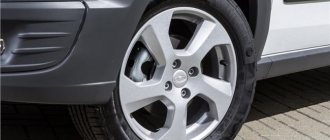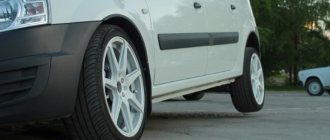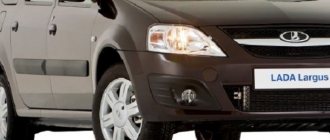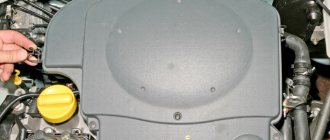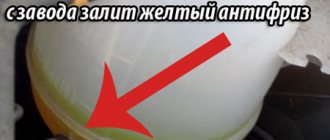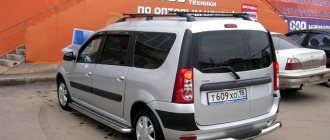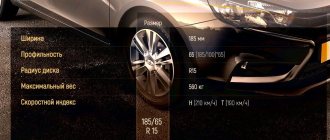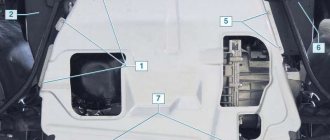Brief overview of the entry
Factory tire size Lada Largus - station wagon, crossover, van
Tire size Lada Largus station wagon 185/65 R15 Cross version - 205/55 R16.
Lada Largus Cross tire size - 15 or 16?
The Lada Largus station wagon of the CROSS modification is equipped from the factory with tires and wheels of a larger diameter, namely size 16 - 205/55R16 91 H.
Lada Largus Cross what tires come from the factory?
Continental Premium Contact size 205/55R16
Lada Largus what tires come from the factory?
KAMA EURO 185/65 R15 88H or AMTEL PLANET 185/65 R15 88T
Tires for the Lada Largus, like for any other car, are an integral and important part on which a large number of different factors depend, such as handling, braking distance, road stability. Even such parameters as fuel consumption and engine power directly depend on the tires installed on the Lada Largus. I’m already silent about a comfortable ride and wear and tear on the suspension, which is directly related to tires.
Compliance criteria for linear dimensions
Wheels with a diameter of 16 inches are standard by default for the Largus Cross when installed at the factory. And if the rim is damaged beyond repair, AvtoVAZ recommends replacing the damaged one with a disc that exactly matches the factory parameters: sixteen-inch, because the dimensions and shape of the wheel were designed for the safest and most trouble-free driving.
Not all motorists follow this rule. Many are guided by appearance and buy a more beautiful rim, not always taking into account its difference in diameter, width, etc. Let's take a closer look at the parameters that can or cannot be changed when installing a new disk.
Each manufacturer recommends certain wheel characteristics. They are indicated in the car’s passport data in the form of a formula. For example, this: 6J15PCD4-98et35DIA58.6, where 6J15 is the width and diameter of the rim in inches, the numbers 4 and 98 indicate, respectively, the number of bolt holes and the distance between the bolts in mm. Et - disc “overhang” (extrusion depth relative to the rim axis). This parameter can be either positive or negative, or zero. 58.6 is the diameter of the central hole in mm.
Purchasing a wheel other than the factory one in the above dimensions affects:
- quality of use of the vehicle chassis;
- suspension wear period;
- driving safety;
- risk of being denied warranty service.
The larger the rim diameter, the smaller the tire profile should be. The profile is also called the height of the tire. This is the vertical distance from where the wheel sits on the tire to the most protruding part of the tread. So this is what we get by increasing the rim. The wheel becomes lighter due to the reduction of the same tire profile, the car becomes more controllable, has better grip on the road, and, accordingly, becomes more stable.
But by increasing the diameter, you reduce the degree of passability of uneven areas, for example, when driving over rough terrain. And also due to the fact that there is less rubber between the rim and the road, it is easier to damage it. There is no point in reducing the profile from its rated value if you drive on poor-quality road surfaces.
The diameter of the center hole may be slightly larger than the diameter of the hub (the central part on which the disc is mounted). In this case, an additional adapter ring is used for installation and balancing.
If the diameter of the hole is smaller than the diameter of the hub, such a rim is not suitable: it simply cannot be secured.
Decoding the Lada Largus tire size parameters
If you do not constantly work with rubber, and your experience with tires ends with purchasing a set once every few years, then you are unlikely to know all the designations printed on the tire. Let's figure out what each of them means.
For example, we have a factory Lada Largus tire with parameters 185/65R15 88H or T.
The first number indicates the width of the tire in millimeters, i.e. 185 mm. The second number is the height of the rubber, but not in millimeters, but as a percentage of the width, i.e. 65% of 185 mm, which equals 120.25 mm. Next comes the designation R. It is common to think that this is the radius, but this is not entirely true. The letter R indicates that the tire has a radial cord. And the number 15 is the mounting diameter of the rim in inches that the tire is designed for, i.e. 15x2.5 = 37.5 cm.
The next number is the load index per wheel. In our case, it is 88. To decipher the speed index, we will use a special table:
It turns out that the maximum load on one wheel of the Lada Largus is 560 kg.
Next comes a letter that specifies the permissible speed at which a car equipped with such a tire can be driven. We also take data from the table in which this designation is deciphered.
In our case, this is H, which equals 210 km/h.
These are the most basic parameters that allow you to choose the right tires. For the average buyer, this will be enough, but there is also extended information that you can find out by carefully examining the tire. For example, on each tire the manufacturer and model of rubber, the production date in the week and year of production format, the direction for installation on the disk, etc. are indicated.
Manufacturing methods and other factors
Linear parameters are not the only deciding factor. Some also choose to change the material the disc is made from. This is an important point - the material from which the purchased disc will be made, as well as the technology for its manufacture. The most popular types of discs found on sale are made of steel, aluminum, magnesium and titanium.
This series is arranged in ascending order of cost. At the same time, steel wheels are the heaviest, but flexible. Aluminum and magnesium alloys produce lightweight parts. This certainly significantly reduces fuel consumption. But such rims are quite easy to damage. But titanium gives the highest strength index. This is what you pay the most.
But for some drivers, it is not necessary to wait for damage to “change” the car. This applies to tuning enthusiasts. But here's what you need to know when choosing the color and appearance of a disc, which is made in different ways. There are stamped, cast and forged discs. So, manufacturing technology affects the ability to obtain a certain color and variety of styles. Stamped and forged wheels, due to the peculiarities of the technology, cannot be presented to customers in aesthetic diversity. But cast ones are easy. They are represented on the market in the largest number of positions.
The degree of damage and fuel consumption also depend on the method of manufacturing the disc. Stamped - they bend when hit, but do not crack. They can be restored. And due to the heavy weight of the car, gasoline costs increase. Another disadvantage is their susceptibility to corrosion, which cannot be said about cast products. But if the cast disc is cracked, it cannot be repaired. But the most expensive type of disc is forged. It is very difficult to deform, and it weighs little.
The manufacturer's recommendations also indicate what the optimal tire pressure should be. After all, it happens that when drivers change cars, out of habit they pump up the tire to one level, but it turns out to be either too low or too high. Both are bad. At a low level, the rubber on the disc is damaged, and at a high level, there is a high probability of breaking through the ramp or damaging the spool.
When choosing the optimal disc option, you should take into account many parameters that match the vehicle and do not forget about safety.
Consequences of installing unsuitable wheels and tires
Using drives that differ in parameters from the factory ones can lead to some of the following unpleasant consequences:
- general quality of chassis operation;
- decreased braking efficiency;
- wear of brake system elements increases;
- wear of suspension elements increases;
- the overall safety of the vehicle is reduced.
In addition, after installing wheels whose dimensions do not match the factory ones, there is a risk that the car will simply be removed from warranty. Which is very sad, considering that we are now talking about completely new cars.
Installing some huge and non-standard wheels on Largus for the sake of giving a unique appearance is not particularly relevant, because the car, as a rule, is used and positioned as a family or work car (depending on the version).
Custom size wheels
On standard wheels it looks quite acceptable, given its positioning. In cases where replacement of disks is carried out out of necessity (for example, serious damage to old ones), it is best to install original ones or choose options that are identical in parameters; by the way, it is easy to find a lot of nice options on the market, this will avoid a number of possible difficulties.
Wheels and tires for Lada Granta FL
Wheels and tires on Niva Travel: selection criteria
LADA Vesta wheels and tires: selection, sizes
Brake discs and drums Lada Largus FL 2021
Lada Vesta SW and SW Cross: full review of brake discs
Source
Which disc is suitable for Lada Largus Cross
As you know, the prefix Cross in the name of the Lada model means that it is an off-road type vehicle. One of the most significant differences between the Cross version and its predecessor Lada Largus is the increased wheelbase. On a regular Largus, four 15-inch disks are installed by default. In Cross, the diameter was increased to 16. By the way, unlike many automakers who indicate possible variations in wheel diameters, AvtoVAZ clearly stated the only acceptable option for the wheel diameter.
What does the size of tires and wheels affect?
| Increasing disc diameter | Increasing rim width | Increasing tire width | |
| Car style | will improve | will improve | will improve |
| Road holding | will improve | will improve | will improve |
| Steering precision | will improve | will improve | will improve |
| Tire grip | Will not change | Will not change | will improve, but only on dry roads |
| Resistance to hydroplaning | Will not change | Will not change | will get worse |
| Comfort on rough roads | will get worse | Will not change | will improve |
| Road noise | Will not change | Will not change | will intensify |
| Gasoline consumption | Will not change | will increase | will increase |
| Tire wear | Will not change | Will not change | will increase |
The smaller the unsprung masses
(this includes a lot of tires and wheels), the better the car will hold the road and accelerate faster. For example, if you put wheels on a car that are 2 kg lighter each, then acceleration to 100 km/h will be reduced by 0.2 seconds.
Attention! Installing larger wheels may lead to problems with ABS and ESP calibration (the systems may not work correctly).
Wheels for cars
Lada Largus is a station wagon with increased capability for transporting cargo. The car was released in 2011. The basis for the car was the Dacia Logan model, which is produced in Romania. "Largus" immediately became quite popular among car enthusiasts due to its increased capacity, low price and ease of maintenance.
Original alloy wheels "Lada Largus"
For any vehicle, wheels and tires are more than just a design element. It is on them that the behavior of the car on the road depends as much as possible. It is customary for all car manufacturers to indicate recommended dimensions for all their models. The AvtoVAZ concern is no exception.
However, it is not always and not among all manufacturers that it is customary to indicate the permissible dimensions and parameters of wheels. Often there are several options listed without specifying the minimum and maximum allowable ones. For example, in the official instruction manual for the Lada, the parameters of the wheels on the Largus are indicated in only two options:
- The usual model of the Largus station wagon should be equipped with products with a radius of R15.
- The all-terrain model "Largus Cross" is equipped with wheels size R16.
The AvtoVAZ concern does not recommend installing wheels of other sizes. Basically, they are replaced when the season changes, possible damage occurs, in which it is undesirable to use the product. In this case, replacing the disks with identical ones is explained by traffic safety.
Wheels for Lada Largus R15
Installing unsuitable wheels can affect the following characteristics:
- traffic safety;
- warranty conditions for the car, if the period has not yet expired;
- high-quality work of parts and suspension units;
- wear of chassis parts.
Since the car has become quite widespread on the roads of the country, there are many offers for the sale of wheels and tires for it. In the original configuration, the Largus is equipped with stamped wheels. In this case, many car enthusiasts are not satisfied with the appearance and characteristics of the car in motion. Then the stamped products are changed to cast or forged. Wheels on Largus size 15 are the only ones provided by the manufacturer, regardless of whether they are stamped or cast.
The Largus Cross model, even in the basic configuration, comes with installed cast parts.
Wheels and tires Lada Largus FL 2022: selection criteria
Wheels play an important role in the technical part of the car and in its appearance. Despite the fact that the new version of the Lada Largus FL has appeared quite recently, the topic of suitable tires and wheels is relevant. Some people simply want to install more attractive wheels on their car, others are preparing to change summer tires to winter ones or vice versa, while others will need this topic for the future.
Today we’ll talk about the wheels of the new Largus, find out the appropriate sizes (radius, profile, etc.) of wheels and tires, and also find out what pressure is recommended to maintain in the tires and other recommendations regarding the wheels of the car.
This will help you understand which wheels or tires to choose for your car for comfortable and safe operation. In addition, we will talk about what can happen if you install the wrong wheels.
How to choose alloy wheels
For the Largus Cross car model, there are many different variations for installing wheel rims. They vary in manufacturing methods, shapes, cost and design.
The characteristics, price and controllability of the machine depend as much as possible on the method of production of the products. For Lada Largus Cross, wheels are made from the following materials:
- Steel. Conventional stamped products are made from it.
- Aluminum and magnesium. Cast or alloy wheels are made from these materials.
- Titanium. In combination with aluminum and magnesium it is a raw material for the production of forged products.
In this case, forged wheels have the minimum weight and maximum strength characteristics. They have long been known for their use in auto racing and have become widespread in the automotive industry. But the forging process does not allow creating a variety of shapes and textures, so such products are limited in design solutions.
Stamped steel wheels can take any shape. Their prices also please car owners. However, high weight and low characteristics negate all the advantages of this manufacturing method.
Casting is another matter. The process allows you to create products of any shape and texture. In terms of weight and strength, these products are slightly inferior to forged ones. But the ability to create a product of any size, width and shape quite cheaply makes these products extremely common on auto store shelves.
You can choose cast products for the Largus Cross machine from a wide range. Products from many brands of various colors, parameters and sizes are presented. The most famous companies Sparco, MOMO and Enkei are famous for their quality. You can choose cheaper products.
Dimensions and dimensions
and “Largus Cross” wheels only in sizes R15 and R16. Installation of products on 17 and 18 inches is possible. However, in this case the warranty will be lost. The comfort level on large wheels will also decrease.
For 15-inch wheels, 195/5 R15 tires are often used; sometimes you can find sizes 205/60 R15, 195/60 R15. Tuning enthusiasts most often install wheels of sizes 205/55 R16, 195/60 R16. Sometimes you can find large ones, such as R17: 215/50 R17, 205/50 R17, and a very rare option are the sizes 215/40 R18, 215/35 R18.
Options
The AvtoVAZ concern added the Cross prefix to the model name for a reason. It is understood that the model has increased off-road capabilities.
The parameters of the basic wheel rims are as follows:
- drilling parameter is 4×100;
- wheel width - 7.0 J;
- disc offset is ET 40;
- centering hole size - 60.1.
Knowing all the various methods for producing wheel rims and their advantages, you can choose a set of quality products for Lada Largus. In order for the disc to fit perfectly, you also need to know the basic parameters and dimensions of the mounts.
Tires directly affect fuel consumption, vehicle cross-country ability, its behavior on the road, and noise level. The appearance of the vehicle also depends on the tires.
AvtoVAZ recommends a certain wheel size for Lada Largus. Let's consider the parameters allowed by the manufacturer and study possible variations. Let's get acquainted with the top 5 winter and summer tires (according to owner reviews).
ATTENTION! A completely simple way to reduce fuel consumption has been found! Don't believe me? An auto mechanic with 15 years of experience also didn’t believe it until he tried it. And now he saves 35,000 rubles a year on gasoline! Read more"
Lada Largus is represented by three models (Largus R90, F90, Cross). Options with 7 or 5 seats are produced (except for the F90 cargo vehicle). The basic requirements for tires and wheels differ only for the Lada Largus CROSS. Parameters important when choosing wheels are indicated in the user manual. The recommended index of load capacity and speed, the standard air pressure are also set in the instructions.
| Model | Size, load capacity index | Center diameter wheel holes (DIA) | Radius between holes (PCD) | Number of nuts, pcs. | Wheel width, inches | Disc offset (ET) |
| R90 | 185/65R 15 88 H | 60,1 | 100 | 4 | 6J | 50 |
| F90 | 185/65R 15 92 H | 60,1 | 100 | 4 | 6J | 50 |
| CROSS | 205/55R 16 91 H | 60,1 | 100 | 4 | 6J | 50 |
Owners consider the categories of acceptable sizes. One of the reasons is the range of prices; manufacturers have better options among non-standard tires. Sometimes rubber remains from an old car. Some people think that the larger the wheel, the better. Let's learn how to choose safe wheels.
Recommended wheel and tire sizes for Lada Largus
The size of tires and wheels not only adds style to the car, but also greatly influences the vehicle's performance on the road. Each manufacturer indicates acceptable standard sizes, and AVTOVAZ is no exception. In this review, we will look at the wheel size of the Lada Largus.
Usually, the manufacturer, depending on the modification of the car, indicates several acceptable wheel sizes, Lada Largus is an exception. The instruction manual indicates the only wheel size for all trim levels: 185/65R15 . Lada Largus wheel parameters: 6Jx15, offset (ET) for R15 = ET50. Wheel hub bolt pattern 4x100. Everyone knows that the Lada Largus is a 2006 Dacia Logan MCV adapted for the Russian market. The technical characteristics of the foreign car indicate exactly the same wheel size.
What is the tire pressure
The tire pressure level is specified in the manufacturer's instructions.
| Model | Front tire pressure, kgf/cm² | Rear tire pressure, kgf/cm² |
| R90 | 2,4 | 2,6 |
| F90 | 2,4 | 3,0 |
| CROSS | 2,4 | 2,6 |
Constant monitoring of this parameter is necessary. Fluctuations to a lesser or greater extent affect the behavior of the car, efficiency, and driving safety. Let's look at the relationship more specifically.
Pressure higher than specified:
- the tire is harder, the comfort of movement decreases;
- the risk of damaging the wheel when hitting a stone or hole increases;
- grip on the road deteriorates;
- braking distance increases;
- the tread pattern wears unevenly;
- wheels rotate easier;
- machine stability improves.
Pressure below normal:
- fuel consumption increases;
- rubber wear increases (due to an increase in the contact patch area);
- car steering accuracy deteriorates;
- stability on the road surface decreases (due to changes in the angle of inclination);
- the risk of skidding increases.
What does the size of tires and wheels affect?
| Increasing disc diameter | Increasing rim width | Increasing tire width | |
| Car style | will improve | will improve | will improve |
| Road holding | will improve | will improve | will improve |
| Steering precision | will improve | will improve | will improve |
| Tire grip | Will not change | Will not change | will improve, but only on dry roads |
| Resistance to hydroplaning | Will not change | Will not change | will get worse |
| Comfort on rough roads | will get worse | Will not change | will improve |
| Road noise | Will not change | Will not change | will intensify |
| Gasoline consumption | Will not change | will increase | will increase |
| Tire wear | Will not change | Will not change | will increase |
The smaller the unsprung masses
(this includes a lot of tires and wheels), the better the car will hold the road and accelerate faster. For example, if you put wheels on a car that are 2 kg lighter each, then acceleration to 100 km/h will be reduced by 0.2 seconds.
Attention! Installing larger wheels may lead to problems with ABS and ESP calibration (the systems may not work correctly).
Frequency of checking tire pressure
The tightness of the wheel structure is not ideal. The air gradually comes out. The reduction in pressure directly depends on the air temperature.
Monitoring must be regular. It is optimal to check your blood pressure at least twice a week. Ideal when leaving a parking lot, visiting a gas station, or performing maintenance.
The measurement should be carried out before the tires heat up (for example in the morning) in all wheels, even in the spare wheel. Checking along the way will not give accurate indicators.
The pressure in the tire should be lower than in the other wheels.
Visual assessment of the condition of tires is an irresponsible attitude towards the vehicle and safety. There is a high risk of not noticing a slight decrease or increase in pressure (0.1-0.5 atmospheres).
It must be remembered that temperature fluctuations and vehicle loading lead to changes in the indicator.
In the following situations, it is recommended to reduce the atmosphere to a level lower than the factory instructions:
- when driving on a slippery road (in winter);
- for off-road driving.
Review of the best summer and winter tires
When choosing tires, owners take into account the following points:
- manufacturer;
- operating conditions (pay attention to the pattern, tread);
- size;
- price category.
Based on reviews from Lada Largus owners, let's summarize.
The majority of survey participants adhere to the recommended sizes. The most popular non-standard tires are 195/65 R15, 195/60 R15, 205/60 R15.
Top 5 summer tires:
- Nokian (HAKKA GREEN 2, Nordman SX);
- Michelin (Energy XM2);
- Continental (ContiPremiumContact 5);
- Matador (MP 44 Elite 3)
- Amtel (Planet T-301). Attention. Complaints about rapid wear. They can burst at high speed.
The tread pattern is:
- asymmetrical;
- directed;
- symmetrical (universal, therefore the most popular).
The latter is ideal for use around the city. It has an affordable price. The downside is unsatisfactory handling at high speed, on wet road surfaces, and when making sharp turns.
Top 5 winter tires:
- Nokian;
- Michelin;
- Continental;
- Goodyear;
- Gislaved/Hankook/Bridgestone.
It is recommended to install standard winter tires. Studded or non-studded - depends on personal preferences and operating conditions. The first option is more popular among Lada Largus owners.
The pattern and tread height are important. You shouldn't skimp on winter tires.
"All-season" is not the best option. They lose to seasonal tires in most respects. In winter, there is a high risk of getting into an accident on such tires.
Application. Table from the instructions.
